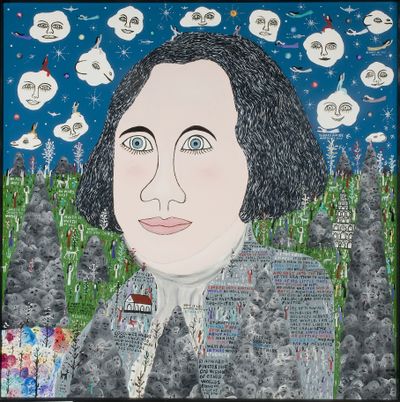Jundt features American South’s self-taught artists

He used house paint to make his bold, vivid-orange-red-and-black “Jonah and the Whale,” hanging in the Jundt Art Museum’s main gallery.
Jimmy Lee Sudduth, of Fayette County, Alabama, hand-mixed his own paint, combining earth pigments and sugar water.
“So it’s Coca-Cola and mud on the surface of these paintings,” said Paul Manoguerra, the Jundt’s director and curator. In Sudduth’s “Old Country Church” and “Tall Church,” also part of the museum’s exhibit “Amen, Amen,” the earth tones are authentic.
The show, open through Jan. 10 at Gonzaga University, pulls together 117 religious works of art by Southern, self-taught artists, all from the private collection of Atlanta residents Carl and Babe Mullis. The work challenges familiar narratives – Bible stories as we might know them – and the definition of art, the artists adapting traditional images using materials they could find and skills they honed on their own.
The work is meant to teach people something, and it’s often evangelical – portrayals of sin and redemption in everyday life.
Collector Carl Mullis was first drawn to folk art in 1993, said Manoguerra, who pulled from the Mullises’ collection for previous shows as a curator in Georgia, before he took over at the Jundt. The collector told him he admired its “wall power,” Manoguerra said, “that it just strikes you, hanging there on the wall – its color, its emotional impact.”
All the artists in “Amen, Amen” were born or lived and worked in the former Confederate states. Some of the work dates to the 1940s. The newest piece was created this year.
The labeling of folk artists, or vernacular artists, or outsider artists, or naïve artists, gets complicated.
“Self-taught,” on the other hand, is specific, Manoguerra said: “The idea is that the artists have not been trained through the usual academic means.”
While some used found materials – corrugated tin, cardboard, poster board, a house shutter – others used materials they knew trained artists would use, such as canvas and oil paints.
It’s art familiar to people in the South, art that people live with, Manoguerra said.
Go into a restaurant in Athens, Georgia, and you might see a Reuben Aaron Miller on the wall, he said. Miller, who lived in Hall County, Georgia, and went by “R. A.,” is among the best known self-taught artists in the South and has 19 pieces in the show.
Work by Howard Finster, a Baptist preacher from Georgia, might be familiar to some outside the South. His work adorned album covers for R.E.M. (“Reckoning”) and the Talking Heads (“Little Creatures”).
The exhibit is arranged by theme.
Angels and devils – including a series of devil-face jugs – confront viewers as they enter the museum through its Arcade Gallery.
Inside the main gallery, the show starts with creation. “Creation,” the painting, an acrylic-on-board representation by Magoffin County, Kentucky’s Hugo Sperger, is “kaleidoscopic almost,” as Manoguerra said – a narrative packed with color and detail. A painted carving called “Get Wise Eat an Apple,” by Atlanta’s Ned Cartledge, shows the serpent as a roadside seller, his wares displayed on an upturned crate.
The show includes traditional images of the Last Supper and a section on the intersection of religion and politics. There are images of churches and the end of the world and religious visions and baptisms.
Portraying another view of the supernatural, artist Sulton Rogers, of Oxford, Mississippi, built a 5-foot-tall, three- dimensional piece called “Haint House” – a haint is a haunt, or ghost – that shows spirits infesting a pink house that could be a dollhouse. The piece doubles as a working lamp.
It’s a diverse, accessible show, Manoguerra said, with no art degree required for the audience, either: “Chances are, with the variety, somebody’s going to find something they can latch onto that they really like.”